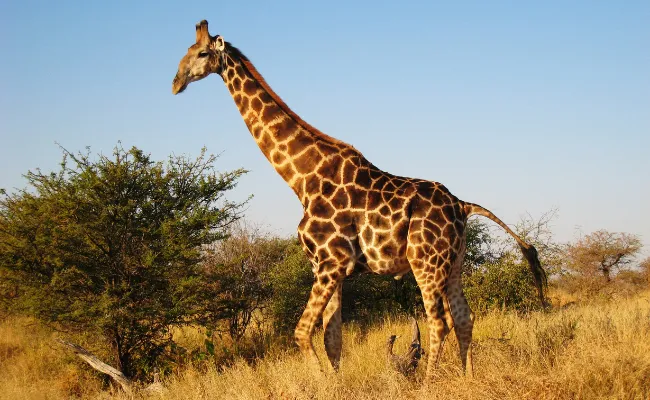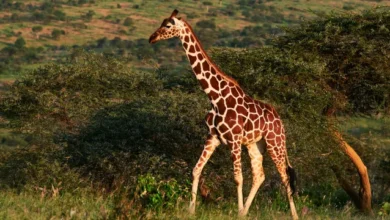
Giraffes, the gentle giants of the African savannas, are truly remarkable creatures. Belonging to the genus Giraffa, these long-necked mammals captivate with their towering stature, distinctive coat patterns, and fascinating behaviors. Let’s delve into the world of giraffes and uncover the wonders of these magnificent creatures.
Anatomy and Physiology
Standing tall as the tallest land animals on Earth, giraffes possess an awe-inspiring height that can reach over 5.5 meters for males and around 4.5 meters for females. Their striking appearance is accentuated by a coat pattern of irregular brown patches on a light background, which serves as effective camouflage in the African grasslands and woodlands.
One of the most distinctive features of giraffes is their remarkably long necks, comprised of only seven elongated cervical vertebrae. These necks, supported by powerful muscles and unique adaptations such as thick-walled arteries with extra valves, enable giraffes to reach foliage almost six meters above the ground. Despite their extraordinary height, giraffes boast a graceful gait, capable of maintaining speeds of up to 50 km/h for extended distances.
Social Behavior and Habitat
Gregarious by nature, giraffes form nonterritorial groups of up to 20 individuals. These herds provide safety in numbers, allowing for increased vigilance against predators such as lions and hyenas. With excellent eyesight, giraffes rely on collective awareness, often taking cues from one another to detect potential threats.
Giraffes inhabit a range of environments, from grasslands to open woodlands, primarily in East Africa. They can be commonly spotted in renowned reserves like Tanzania’s Serengeti National Park and Kenya’s Amboseli National Park. Despite their imposing stature, giraffes prefer to feed on new shoots and leaves, mainly from the thorny acacia tree, showcasing their selective browsing habits.
Reproduction and Survival
Female giraffes typically breed for the first time at four or five years of age, with a gestation period lasting 15 months. Upon birth, calves enter the world already towering at around two meters tall and weighing approximately 100 kilograms. Mothers nurture their offspring with utmost care, forming strong bonds during the early stages of life.
However, the journey to adulthood is fraught with challenges. Young giraffes face threats from predators, with lions and hyenas posing significant risks, particularly during vulnerable moments like nursing. Despite these perils, giraffes display remarkable resilience, adapting to their environment and forming intricate social structures that enhance their chances of survival.
Conservation Status and Future
While giraffes have long been regarded as symbols of Africa’s natural heritage, they face increasing threats in the modern world. Habitat loss, illegal hunting, and civil unrest have contributed to a significant decline in giraffe populations in recent decades. As a result, the International Union for Conservation of Nature (IUCN) reclassified the conservation status of giraffes as vulnerable in 2016, signaling the urgent need for conservation efforts.
Despite these challenges, there is hope for the future of giraffes. Conservation initiatives, supported by dedicated scientists, conservationists, and local communities, aim to safeguard these majestic creatures for generations to come. By preserving their habitats, combating poaching, and raising awareness, we can ensure that giraffes continue to roam the African savannas, inspiring wonder and admiration for years to come.
Facts About Giraffes
- Giraffes are the tallest land animals on Earth, with males reaching heights of over 5.5 meters and females around 4.5 meters.
- Their distinctive coat patterns, characterized by irregular brown patches on a light background, provide effective camouflage in their natural habitat.
- Giraffes possess remarkably long necks, comprised of only seven elongated cervical vertebrae, allowing them to browse foliage nearly six meters above the ground.
- These gentle giants are herbivores, primarily feeding on new shoots and leaves, with a particular preference for the thorny acacia tree.
- Giraffes are social animals, forming nonterritorial groups of up to 20 individuals, which enhances their vigilance against predators like lions and hyenas.
Information About Giraffes
- Scientific Name: Genus Giraffa
- Family: Giraffidae
- Order: Artiodactyla
- Giraffes belong to the family Giraffidae, which includes their closest relative, the rainforest-dwelling okapi.
- They are classified into four species: the northern giraffe (G. camelopardalis), southern giraffe (G. giraffa), Masai giraffe (G. tippelskirchi), and reticulated giraffe (G. reticulata).
Habitat of Giraffes
- Giraffes inhabit a range of environments, including grasslands, open woodlands, and savannas, primarily in East Africa.
- They can be found in renowned reserves such as Tanzania’s Serengeti National Park and Kenya’s Amboseli National Park.
- Giraffes prefer areas with abundant foliage for browsing and open spaces for visibility, allowing them to detect predators and other members of their group easily.
Species of Giraffes
- Northern Giraffe (Giraffa camelopardalis)
- Includes several subspecies such as the West African giraffe, Kordofan giraffe, Nubian giraffe, and Rothschild’s giraffe.
- Southern Giraffe (Giraffa giraffa)
- Includes subspecies such as the Angolan giraffe, South African giraffe, and Namibian giraffe.
- Masai Giraffe (Giraffa tippelskirchi)
- Reticulated Giraffe (Giraffa reticulata)
Lifespan of Giraffes
- In the wild, giraffes have an average lifespan of up to 26 years.
- In captivity, they may live slightly longer, provided they receive proper care and habitat conditions.
- Factors such as predation, disease, and environmental conditions can affect the lifespan of giraffes in the wild.
In conclusion, giraffes stand as magnificent symbols of Africa’s rich biodiversity, captivating the imagination with their towering presence and graceful demeanor. As stewards of our planet, it is our responsibility to protect and cherish these iconic animals, ensuring that they thrive in the wild for future generations to marvel at their beauty and resilience.



